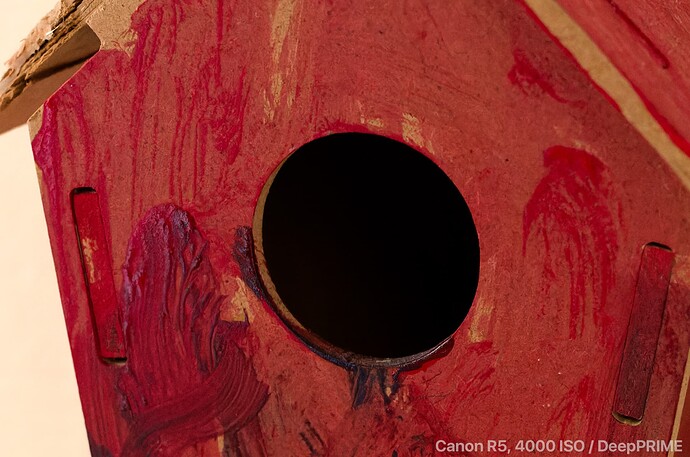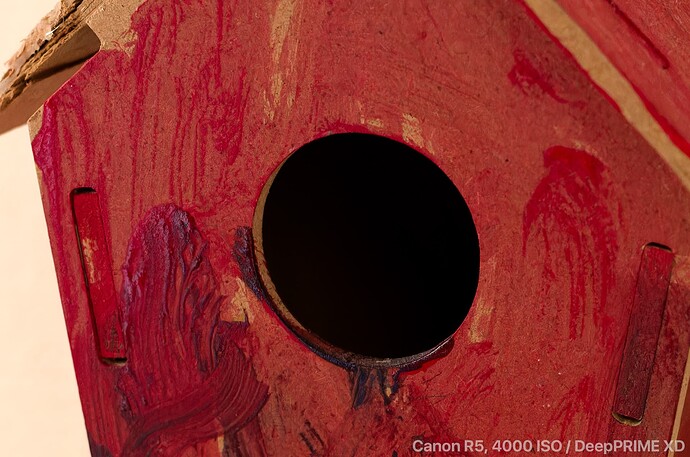The patterns you’ve shown are not what I look at when it comes to de-noising. Try photographs of a sky or very simple background taken at mid to high ISO. DP and DPXD absolutely shine above others and I’ve compared them to Photoshop, LightRoom and Topaz DeNoise AI. The proof of the pudding is in the eating and one of the reasons I use PL6 is it eats all others when it comes to reducing noise.
…just to add to the OP…
I’m using PhotoLab as well as Topaz’s software.
I’m really impressed when Topaz Sharpen AI saves a blurry shot for me. Sometimes, really, I look at the “before/after” and I’m baffled.
But for demosaicing/denoising, I have settled for DxO. Their DeepPrime / XD algorithm is incredible, really. As of today, I made a test at 4000 ISO, with an indoor shot in poor lighting conditions.
The number of details and colors that PhotoLab is able to extract from the RAW is just INSANE.
Look at the 100% crops below. (the subject is a cardboard bird’s house made by my son. The material has the typical “recycled paper look” and it was sometimes painted with thick brush strokes…).
I mean, the DP/XD output looks from another planet.
Everything was shot on a Canon R5 with an RF lens…I mean, not a “disposable” camera if you will…
I don’t know, I’m speechless. As they say, an image is worth a thousand words…
Ian
As you have no reference, only 4000 ISO pictures, how can you be sure that one of those is closer to the real scene than the others?
I’ve made a test comparing a 200 ISO + non NR with a 25600 ISO + DPXD (and 25600 ISO + DP).
Depending on how you tune DPXD, you may see artefacts in very noisy places.
So, in my opinion, based on my tests, DP is the easiest way to obtain a very good result with it’s default settings. If you need to process a picture with very small details, DPXD will give the best result but you will need to tune it.
“As you have no reference…”??
What do you mean? I took the picture of an object I own which is on my desk.
I know what the “reference” looks like!
The whole point is that most people think that DP/XD is there just to get rid of the noise, which IS NOT TRUE. As DxO says in their documentation, their algorithm does demosaicing & denoising.
Two things, not just one. Of course to intercept noise it’s best to start by demosaicing the RAW (after all this is what all similar software tell you “You’ll get better results with the original RAW file”), but my point is that even with a good image, demosaicing it using anything less than DP/XD will result in data loss.
Just look at the above examples…all the cardboard/paint texture has been washed out by using the HQ algorithm (please note: all images have been processed using all the same optical corrections provided by PL). At the same time, using DP/XD I can see all the tiny details and more accurate colors (for instance on the HQ version most of the stains/dirt/speckles on the surface have the same hue, while in reality there are variations in those little details, as you can clearly see in the other 2 crops…)
Ian.
“What do you mean? I took the picture of an object I own which is on my desk.
I know what the “reference” looks like!”
I do not see what is on your desk. So this doesn’t mean anything to me.
Put two pictures, one at 200 ISO with no NR and the same at 4000+ ISO with DP then DPXD and I can compare. Else I just have to believe what you wrote.
But, having made my own tests, I believe what you wrote… ![]()
I don’t understand the purpose of your test.
I thought these extreme algorithms are for photos with extreme noise, not for perfectly lit, razor-sharp, perfectly exposed test images.
@MarshallG it is but if you are testing the veracity (accuracy, truthfulness etc.) of an algorithm then you would test it on perfect images as well as noisy ones to determine its accuracy under a variety of circumstances.
Deep Prime is not only for noise, it is also a demosaicing algorithm. Many here use it as default.
See also here: DeepPRIME - Denoising and RAW conversion with AI
Agree. I use DeepPRIME or DeepPRIME XD on every image, regardless of the ISO setting or whether or not there is extreme noise. DxO designed these features to be used on every raw file, not just the very noisy ones. Most of the regulars on this site use it 100% of the time. These AI based products, also included in PureRAW 3, were specifically designed for that purpose.
Mark
Not necessary on low ISO images, but seems to do limited harm. With a full frame camera, there’s no real image improvement with noise reduction (DeepPrime) until ISO 800.
DeepPrime XD includes artificial detail enhancement so if imaginary detail floats your boat it may have some value even at low ISO.
I generally use DeepPRIME XD only on heavily cropped images and the improvement in fine detail is usually very significant and mostly natural looking to my eyes. However, I don’t always prefer the XD results, even for cropped images.
Mark
Even at low ISO, if you need to raise some shadows, DP may help.


